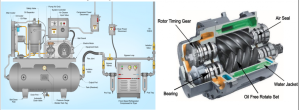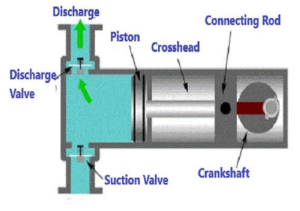A reciprocating compressor is a positive displacement machine that compresses a gas through the reciprocating action of a piston and delivers it at high pressure. Rugged and efficient, these machines have the widest pressure range among compressors. Reciprocating compressors are most commonly used for transmission of natural gas through pipelines and for supplying high-pressure gas for oil well drilling. However, they also used in petrochemical plants, refineries and other applications where high compression ratios are required.
A reciprocating compressor has three main areas that require lubrication:
- Crankcase – this includes the crankshaft, bearings, bushings, timing gears, the crosshead and connecting rods
- Cylinders – this includes the cylinder liner, piston rings and valves
- Packing – these include packing seals which contain the gas pressure within the cylinder and oil wiper packing
Typically, two lubrications systems are used. The first is generally a circulating system which lubricates the crankcase and related components. The second is a total loss system which lubricates the cylinders and packing.
Crankcase lubrication is the simpler process. A natural gas engine oil is generally used as it is readily available and the drive for these compressors is often a natural gas engine.
The lubricant for the cylinders and packing is subjected to harsher conditions than that for the crankshaft. This lubricant must perform its job while subjected to extremely high pressures and temperatures, and possibly chemical attack from compressed gas. Furthermore, as high-pressure gases mix with the lubricant, the viscosity may be reduced in a process known as dilution. The cylinder lubricant is determined by the discharge pressure and the type of gas being compressed. For wet, sour and solvent gases or for high discharge pressures, a special cylinder oil is recommended. Typically, an ISO 220 to ISO 460 viscosity mineral oil is used to account for the more severe conditions. One offshore operator in Trinidad also uses an ISO 680 compounded lubricant for this application.
Alternatively, an ISO 150 or ISO 220 polyalkylene glycol (PAG) oil could be used. PAG lubricants do not absorb any of the hydrocarbon gases and therefore do not thin out or get washed off of the cylinder walls by the high-pressure gas. PAG lubricant also do not leave any residue or deposits on valves or piston rings. In this respect – a PAG type lubricant is more cost effective in this applications.







